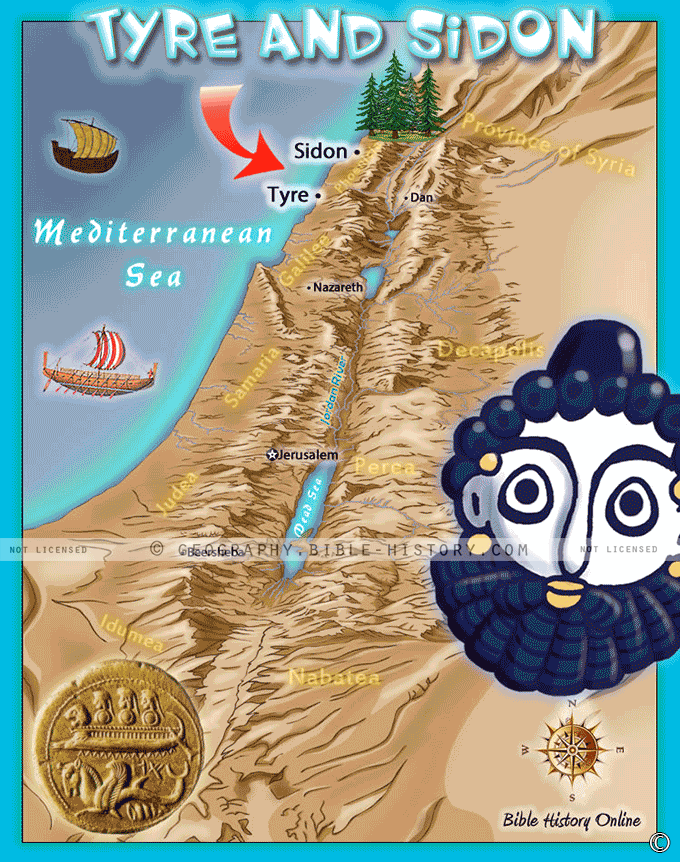
Nestled along the shores of the Mediterranean Sea, Tyre and Sidon stand as testament to the enduring allure of ancient port cities. These Phoenician metropolises have left an indelible mark on history, their stories interwoven with maritime trade, cultural exchange, and the rise and fall of empires. As we explore Tyre and Sidon, we journey through time, unearthing the treasures of these coastal gems and discovering their role in shaping the course of civilizations.
Maritime Marvels of Antiquity
Tyre and Sidon were renowned as bustling ports that facilitated trade between the ancient Mediterranean world and distant lands. These cities thrived on maritime commerce, establishing Phoenicia as a hub of economic activity and cultural exchange. Their shipyards produced vessels that sailed to the far reaches of the known world, contributing to their reputation as maritime marvels of antiquity.
Cultural Crossroads
The prosperity of Tyre and Sidon was not limited to trade alone; they were also vibrant centers of culture and innovation. As trade routes converged in these cities, they became melting pots of diverse cultures, languages, and ideas. The exchange of goods was accompanied by the exchange of knowledge, fostering a rich tapestry of art, architecture, and intellectual pursuits.
Tyre's Island City and Sidon's Legacy
Tyre's unique geography – an island city fortified against the sea – contributed to its reputation as an unconquerable fortress. Its famed purple dye production made it synonymous with luxury and royalty. Sidon, on the other hand, was celebrated for its skilled artisans and its contributions to the arts and sciences. Together, these cities stood as beacons of Phoenician ingenuity and cultural prowess.
Encounters with Great Empires
The history of Tyre and Sidon is also marked by their encounters with great empires. From the Babylonians to the Persians, the Greeks to the Romans, these cities played pivotal roles in the geopolitical landscape. Their alliances, conflicts, and eventual subjugation reflect the ebb and flow of power that shaped the ancient world.
A Legacy of Resilience
Despite facing the tides of time and the ravages of conquest, the legacy of Tyre and Sidon endures. Their archaeological remains offer glimpses into their grandeur, revealing intricate mosaics, imposing ruins, and remnants of their maritime heritage. Their stories serve as a reminder of the impermanence of empires and the enduring impact of human endeavors.
Tyre and Sidon stand as living testaments to the power of trade, culture, and human resilience. Their stories illuminate the interconnectedness of civilizations, the transience of power, and the indomitable spirit of cities that have weathered the passage of millennia. By delving into their histories, we gain insights into the intricate web of history that binds humanity across time and space, inviting us to reflect on the legacies we ourselves leave behind.
Blank Topo Map of The World
Abraham’s Journey
The Captivity of Judah (586-516 B.C.)
The Fall of Judah 586 B.C.
The Northern Kingdom of Israel
The Southern Kingdom of Judah
The Divided Kingdom
The Fertile Crescent
Ur of the Chaldees
Shechem in Old Testament Times
Prophets, Kings, and Nations
Jesus Last Passover
New Testament Israel
New Testament Places
Old Testament Israel
Provinces of the Roman Empire
Israel during David’s Kingdom
David’s Kingdom
Cities of the New Testament 4
Cities of the New Testament 3
Cities of the New Testament 2
Mediterranean Sea
Cities of the New Testament
First Century Jerusalem
Empire of David and Solomon
David’s Kingdom
Israel Under Rehoboam
Ophir and Tarshish
The Period of the Kings
Ramoth Gilead
Samaria
Solomon’s Temple
Zarephath and MT Carmel
Jabesh Gilead and Tribes
Judah in the Time of David
Kingdom of Saul
Kirjath Jearim
Michmash
Mount Gilboa in the Time of David
Nob Davids Flight
Shiloh
Israel and Judah
Assyrian Empire Under Esarhaddon
Assyrian Empire Under Sennacherib
Captivity of 10 Tribes
Events in 2 Kings
The Khabur River
Israel and Syria
Captives From Judah
Kingdom of Jeroboam
Mesha’s Kingdom
Pharaoh Necho Battles King Josiah at Megiddo
Babylonian, Mede and Persian Empires
Samaria and Nearby Territories
Syria at its Height
Hebron
Mahanaim
1949 Map of Israel With Boundaries
First & Second Journeys of Paul
Journeys of the Apostles
Paul’s Third Missionary Journey
Saul’s Journey to Damascus and Arabia
Paul’s Final Visits
Paul’s 1st Missionary Journey
Paul’s 2nd Missionary Journey
Paul’s 3rd Missionary Journey
Paul’s Voyage to Rome
Phillip Journeys to Samaria and Gaza
Judah at the Time of Amos
Empire of Alexander the Great
Israel Under the Maccabees
Galilee During Maccabees
Idumea Intertestamental Period
Kingdom of the Ptolemies
Kingdom of the Seleucids
Ptolemaic Egypt Seleucid Asia
The Roman World
Kingdom of Ptolemies and Seleucids
The World During the 6TH Century BC
Mount Horeb
The Red Sea
The Exodus
Ezra’s Journey to Restore Jerusalem
Israel and Judah During Hosea’s Time
The Ancient World
Canaan During the Time of Abraham
The City of Shechem
Supposed Location of the Garden of Eden
The Land of Israel in Genesis
The Jordan River
The Kingdom of Nimrod
Mount Ararat and Mesopotamia
The Descendants
Sodom and Gomorrah
The Kingdom of Egypt
The Hamites
The Kingdom of the Hittites
Ur of the Chaldees
Judah at the Time of Haggai
Jesus Passes Through Samaria
